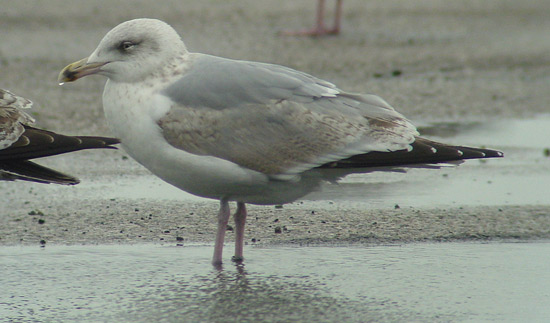 Herring
Gull - Zilvermeeuw (argentatus & argenteus): sub-adult February
Herring
Gull - Zilvermeeuw (argentatus & argenteus): sub-adult February
(last update: 07 april 2004)
Home
Links
to Gull Sites
Gull Taxa
Gull Topography
Grey & Colour Charts
Locations in NW Europe
Summaries of Articles
About ORG
@
A 4cy argenteus ringed as pullus on July 08 2000 at Zeebrugge, Belgium (51.20N 03.11E): Bruxelles H-108933. This agenteus shows all the familiar characteristics of a 4cy in February:
- note the small white mirror on P10, visible from below in the field,
- the white tips of the third generation primaries are relatively small compared to the primaries of an adult argenteus Herring Gull,
- the tail has obvious vestiges of immaturity: black central markings visible in the field,
- the lower tertials have much brown patterning and they probably are the oldest tertials (but not necessarily of an earlier generation than the other tertials, as the tertial moulted first in line may appear much more immature than later acquired feathers of the same tract),
- a combination of completely adult-like scapular and mantle region and patterned (barred) greater, median and lesser coverts,
- the extensive dark bill-band and greyish iris.
From January to April, 4cy argenteus moult to so-called "third summer" plumage. The head and under-parts will appear all-white by early May. The tail-feathers, wing-coverts and primaries are not replaced in this moult, therefore most birds strongly resemble "third winter" birds, although the white primary tips wear away and dark patches start to bleach. The iris is often yellowish, the orbital ring yellowish-orange in argenteus and the bill predominantly yellow with a red gonydeal spot and limited black markings along the culmen by April.
